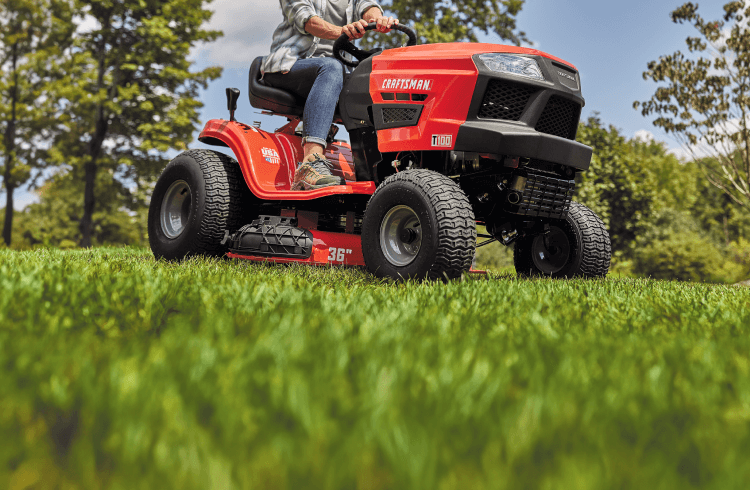Riding Lawn Mowers


FAQs
-
There are several types of lawn mowers, but the most common are walk behind mowers (also known as push mowers), self-propelled, riding mowers (also often referred to as lawn tractors) and zero turn lawn mowers.
Gas Lawn Mowers: Require the use of gas engine and gasoline to run the unit. Gas units can handle large lawns but do require engine maintenance.
Corded Lawn Mower: Use the mower's cord and an extension cord in an outlet to power the mower. These mowers are typically quieter than gas lawn mowers.
Cordless Lawn Mower: These mowers' motors are powered by batteries that are rechargeable. Cordless lawnmowers do not have a physical cord attached to run the unit. These mowers are typically quieter than gas lawn mowers.
Push Mowers: These are the most common type of lawn mowers, and they come in gas-powered, corded, and cordless models. They are designed to be pushed by the operator and are ideal for small to medium-sized lawns with flat terrain.
Self-propelled Lawn Mowers: These mowers are designed to move forward when the self-propel mechanism is engaged, requiring less effort from the operator than push mowers. They come in front wheel drive and rear wheel drive which indicates which set of wheels propel the unit forward. They are ideal for hilly or uneven terrain.
Riding Lawn Mowers: These mowers are designed to be ridden by the operator and are ideal for larger lawns. They come in different sizes and are available with gas-powered or electric engines.
Zero-turn Lawn Mowers: These mowers are similar to riding mowers but have a turning radius of zero, which makes them highly maneuverable. They are ideal for large, flat lawns with obstacles.
-
Walk-behind lawn mowers are the most common type of lawn mowers and come in gas-powered, corded, and cordless models. They are designed to be pushed by the operator and are ideal for small to medium-sized lawns with flat terrain. Some walk behind lawn mowers are self-propelled, which requires less effort from the operator than push mowers. Self-propelled lawn mowers are ideal for hilly or uneven terrain.
-
Self-propelled mowers are designed to move forward when the self-propel mechanism is engaged, requiring less effort from the operator than push mowers. There are two main types of self-propelled mowers: front-wheel drive and rear-wheel drive.
In a front-wheel drive self-propelled mower, the front wheels are powered. The rear wheels are free-spinning and help to provide stability and control. The operator controls the speed of the mower with a lever or dial.
In a rear-wheel drive self-propelled mower, the rear wheels are powered. The front wheels are free-spinning and help to provide stability and control. The operator controls the speed of the mower with a lever or dial.
Both front-wheel drive and rear-wheel drive self-propelled mowers can be equipped with adjustable speed settings, which allow the operator to choose a comfortable speed for the task at hand.
Self-propelled mowers are ideal for hilly or uneven terrain, as they help reduce the operator's effort and provide greater control than push mowers. They are available in gas-powered, corded, and cordless models, and come in a variety of sizes and cutting widths to suit different lawn sizes and needs.
-
When buying a lawn mower, there are several factors to consider:
Lawn Size: The size of your lawn is an important consideration when choosing a lawn mower. A small lawn may only require a walk behind mower, while a large lawn may need a riding mower.
Terrain: The terrain of your lawn is also an important consideration. If your lawn is hilly or uneven, a self-propelled mower might be a better option than a push mower.
Power Source: Lawn mowers are available in gas-powered, corded, and cordless models. Electric mowers are quieter and require less maintenance than gas mowers. Cordless mowers offer the convenience of electric mowers without the need for a power outlet.
Cutting Width: The cutting width of a lawn mower determines how much grass it can cut in one pass. A wider cutting width will reduce the number of passes needed to mow your lawn, but it may also require more power.
Cutting Height: The cutting height of a lawn mower determines how short it can cut the grass. Some mowers have adjustable cutting heights, which is useful if you want to maintain different grass lengths.
Bagging and Mulching: Some mowers are designed to bag the grass clippings, while others are designed to discharge or mulch the clippings and leave them on the lawn. Many mowers incorporate some or all of these options. Consider which option(s) you prefer.
Price: Lawn mowers are available at a range of price points, from budget-friendly to high-end models. Consider your budget and the features you need before making a purchase.
-
A zero turn mower is a riding lawn mower that has a turning radius of zero degrees. This means that the mower can turn on its own axis, without leaving any uncut grass or having to make multiple passes.
Zero turn mowers are typically larger and more powerful than traditional riding mowers, and they are designed for professional landscapers and homeowners with large lawns. They are ideal for mowing lawns with obstacles, such as trees, flower beds, and other landscaping features.